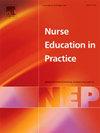Midwifery students' evaluation of midwifery practice experiences in Australia: A national survey
IF 3.3
3区 医学
Q1 NURSING
引用次数: 0
Abstract
Aim
To report the findings of the first 12 months of a national survey of midwifery students’ evaluation of midwifery practice experiences in Australia.
Background
Accreditation standards for midwifery programs globally and in Australia, require evidence of monitoring and evaluation of student midwifery practice experiences. In 2022 the National Placement Evaluation Centre was commissioned to measure and enhance the quality of nursing and midwifery practice experiences.
Design
Survey
Methods
A national survey of midwifery students who completed midwifery practice experience in Australia between 1 July 2023 and 30 June 2024.
Results
Midwifery practice experiences (n = 871) were evaluated; most were rostered placements in a maternity unit. Overall, the quality of the clinical learning environment and of learning support were rated highly and 87 % of students were very satisfied with their midwifery practice experiences. Older students and indigenous students rated their midwifery practice experiences lower than younger, non-indigenous students. Higher quality PET-(Midwifery) scores were associated with antenatal placement (p 0.004). Students who were aged 30–39 (p < 0.001) and conducted their placement between 15 and 21 days (p = 0.010) or 29 days and longer (p = 0.029), rated lower than those completing their placement with 1–7 days.
Conclusions
This national study provides benchmark data and valuable insights into the midwifery student practice experiences across Australia. Future research should continue to monitor and ameliorate the nuanced dynamics of participant and placement characteristics, ensuring that all students, regardless of age or background, have access to high-quality, supportive midwifery practice experiences that prepare them for the demands of contemporary midwifery.
澳大利亚助产学学生对助产实习经历的评价:一项全国性调查
目的报告前12个月助产学学生对澳大利亚助产实践经验评估的全国性调查结果。全球和澳大利亚的助产学课程认证标准需要对学生助产学实践经验进行监控和评估的证据。2022年,国家就业评估中心被委托衡量和提高护理和助产实践经验的质量。设计调查方法对2023年7月1日至2024年6月30日在澳大利亚完成助产实习经验的助产学学生进行全国性调查。结果对助产士实习经验(n = 871)进行评价;大多数是在产科病房的名册安排。总体而言,临床学习环境和学习支持的质量得到了很高的评价,87% %的学生对他们的助产实习经历非常满意。年龄较大的学生和土著学生对助产实践经历的评价低于年龄较小的非土著学生。较高质量的PET-(助产)评分与产前放置相关(p 0.004)。年龄在30-39岁之间(p <; 0.001),在15 - 21天(p = 0.010)或29天及以上(p = 0.029)的学生评分低于在1-7天完成安置的学生。这项全国性的研究为澳大利亚助产学学生的实践经验提供了基准数据和有价值的见解。未来的研究应继续监测和改善参与者和安置特征的细微动态,确保所有学生,无论年龄或背景,都能获得高质量的支持性助产实践经验,为当代助产学的需求做好准备。
本文章由计算机程序翻译,如有差异,请以英文原文为准。
求助全文
约1分钟内获得全文
求助全文
来源期刊

Nurse Education in Practice
NURSING-
CiteScore
5.40
自引率
9.40%
发文量
180
审稿时长
51 days
期刊介绍:
Nurse Education in Practice enables lecturers and practitioners to both share and disseminate evidence that demonstrates the actual practice of education as it is experienced in the realities of their respective work environments. It is supportive of new authors and will be at the forefront in publishing individual and collaborative papers that demonstrate the link between education and practice.
 求助内容:
求助内容: 应助结果提醒方式:
应助结果提醒方式:


